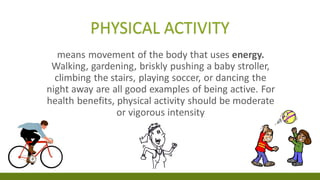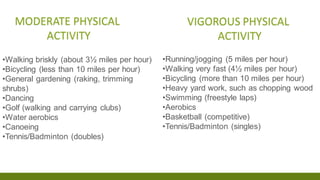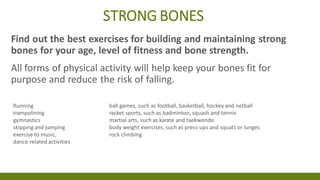l01-physicaleducationhealth11.pdf
- 1. PHYSICAL EDUCATION & HEALTH 11 PHYSICAL ACTIVITY PRACTICUM MARVIN B. BRO?OSO PE & HEALTH TEACHER 09186975164
- 2. LEARNING COMPETENCIES ? Distinguishes aerobic from muscle-and bone-strengthening activities ? Explains how to optimize the energy systems for safe and improved performance
- 3. means movement of the body that uses energy. Walking, gardening, briskly pushing a baby stroller, climbing the stairs, playing soccer, or dancing the night away are all good examples of being active. For health benefits, physical activity should be moderate or vigorous intensity PHYSICAL ACTIVITY
- 5. MODERATE PHYSICAL ACTIVITY VIGOROUS PHYSICAL ACTIVITY ?Walking briskly (about 3? miles per hour) ?Bicycling (less than 10 miles per hour) ?General gardening (raking, trimming shrubs) ?Dancing ?Golf (walking and carrying clubs) ?Water aerobics ?Canoeing ?Tennis/Badminton (doubles) ?Running/jogging (5 miles per hour) ?Walking very fast (4? miles per hour) ?Bicycling (more than 10 miles per hour) ?Heavy yard work, such as chopping wood ?Swimming (freestyle laps) ?Aerobics ?Basketball (competitive) ?Tennis/Badminton (singles)
- 6. PHYSICAL BENEFITS ?Cardiovascular System Your heart and blood vessels receive the most benefits from regular physical activity. ?Weight Maintenance Staying at a healthy weight can reduce your risk for developing diseases such as diabetes, heart disease, and certain cancers. ?Bone Strength Your physical activities make your bones stronger and denser. ?Balance and Coordination Physical activity improves your balance and coordination, which may, in turn, improve your athletic ability.
- 8. LIFTING HEAVY WEIGHT ARE YOU ??? STRETCHING YOUR MUSCLE
- 9. OR MAYBE YOU'RE PERFORMING AN ACTIVITY THAT CAUSES YOU TO SWEAT AND BREATHE HARD THAT MAKES YOUR BLOOD PUMP THROUGH YOUR VEINS AS IT CARRIES OXYGEN TO YOUR MUSCLES TO KEEP YOU GOING.
- 10. If you're performing this last activity, then you're engaging in aerobic exercise.
- 11. ?Aerobic exercise is any physical activity that makes you sweat, causes you to breathe harder, and gets your heart beating faster than at rest. It strengthens your heart and lungs and trains your cardiovascular system to manage and deliver oxygen more quickly and efficiently throughout your body. Aerobic exercise uses your large muscle groups, is rhythmic in nature, and can be maintained continuously for at least 10 minutes.
- 12. BENEFITS OF AEROBIC In addition to strengthening your heart and cardiovascular system, participation in regular aerobic exercise has many health benefits. Aerobic exercise: ? Improves your circulation and helps your body use oxygen better ? Increases energy ? Increases endurance, which means you can workout longer without getting tired ? Helps reduce the risk of developing heart disease ? Helps reduce the risk of developing diabetes ? Helps reduce body fat ? Helps you reach and maintain a healthy weight ? Helps reduce stress, tension, anxiety, and depression ? Improves sleep
- 13. EXAMPLES OF AEROBIC EXERCISE ? Physical activity such as walking, jogging, indoor cycling, or aerobic dancing are all examples of aerobic exercise that strengthen the heart and lungs, therefore improving your body's utilization of oxygen. For general health, aim for a 30-minuteworkout (or three 10-minute workouts per day) three to five days a week at moderate intensity. Moderate intensity refers to an activity that will increase your breathing and get your heart beating fast. You should be able to talk with ease during moderate intensity workouts, though trying to sing would be more challenging. ? For weight loss, gradually work up to 45 minutes or longer at moderate to vigorous intensity five to six days a week, allowing for at least one day of rest a week. Vigorous intensity refers to an activity that will have your heart beating quite a bit more than moderate intensity workouts, and your breathing will be harder so saying more than a few words will be difficult.
- 14. STRONG BONES Find out the best exercises for building and maintaining strong bones for your age, level of fitness and bone strength. All forms of physical activity will help keep your bones fit for purpose and reduce the risk of falling. Running ball games, such as football, basketball, hockey and netball trampolining racket sports, such as badminton, squash and tennis gymnastics martial arts, such as karate and taekwondo skipping and jumping body weight exercises, such as press-ups and squats or lunges exercise to music, rock climbing dance-related activities
- 15. STRONG BONES Bone-strengthening activities produce an impact or tension force on the bones that promotes bone growth and strength. Running ball games, such as football, basketball, hockey and netball trampolining racket sports, such as badminton, squash and tennis gymnastics martial arts, such as karate and taekwondo skipping and jumping body weight exercises, such as press-ups and squats or lunges exercise to music, rock climbing dance-related activities Skipping Rope
- 16. MUSCLE STRENGTH Should work with muscles as they move against resistance. This resistance can come from workout machines, free weights or barbells, elastic bands, water, stairs, hills, cans of vegetables from the pantry -- even your own body weight as you do a pushup.
- 17. MUSCULAR STRENGTH AND ENDURANCE Muscular strength and endurance are important components of health related fitness because they can help you stay "injury-free" and prevent some health problems (example: neck and lower back pain).
- 18. MUSCULAR STRENGTH AND ENDURANCE ?Muscular strength and endurance can also help you maintain bone strength, and can help to improve your fitness level and sport performance.
- 19. MUSCLE STRENGTHENING EXERCISES: Increase your muscular strength, power, endurance, and mass.
- 20. HERE ARE A FEW EXAMPLES OF ACTIVITIES: ¡ñ Skipping rope ¡ñ Jogging ¡ñ Playing sports such as gymnastics, basketball, volleyball, and tennis.
- 21. Remember to work your muscles and your bones at least three times a week! Be active every day!
- 22. EQUIPPING ACTIVITIY ? What were the physical activities in your childhood ? ? What are the physical activities you do now as a teenager?





















